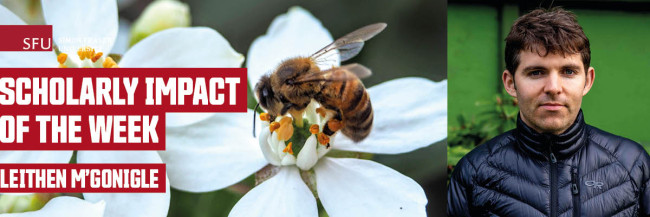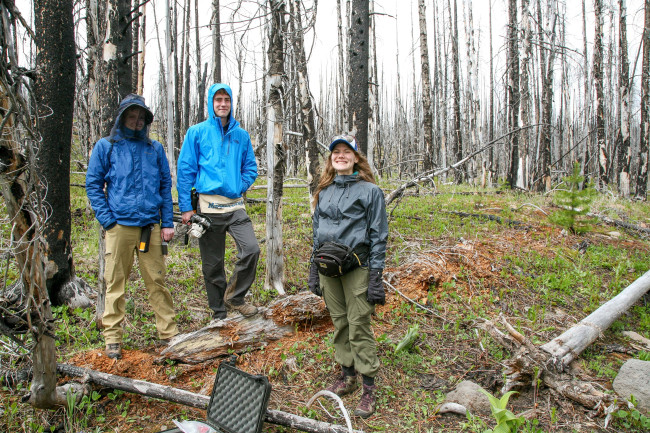
As climate change increases the risk of fire to forested areas, a better understanding of the postfire environment is critical to all species who depend on the forest, including some of its smallest inhabitants.
Bumble bees are important pollinators in temperate forest regions where fire is a driving force for habitat change. While postfire environments have shown to have a positive effect on bees—burned sites support floral abundance and diversity, which also supports pollinators—the extent to which fire impacts bumblebee populations in these areas is not well-understood.
Biological sciences professor Leithen M’Gonigle studies and teaches terrestrial ecology and leads the M'Gonigle Lab, which uses scientific methods to ask questions about diverse topics in ecology and evolution.
To better understand how postfire environments affect bumble bees, M’Gonigle and his research team studied canopy cover, floral diversity and bee diversity of 26 areas in the unceded territories of the Nuxalk and Ulkatcho First Nations, in and around Tweedsmuir Provincial Park, British Columbia. Half of the sites were fire affected, or “burned” and half were “unburned,” or unaffected by fire.
The research team included SFU PhD student Sarah Johnson, masters student Hanna Jackson, and undergraduate researcher Hutton Noth. They observed 10 of the 11 predicted bumble bee species and 76 different open floral species in the study areas.
Interestingly, they found that many attributes of burned sites that are typically thought to make sites better for bumble bees—for example, an open forest canopy—actually just increase our own ability to detect bees.
The study, Positive impact of postfire environment on bumble bees not explained by habitat variables in a remote forested ecosystem, was recently published in Ecology and Evolution.

Co-lead researcher Sarah Thompson [right] and members of the M’Gonigle Lab in the field: SFU researcher Rowan Rampton [left] and NRSERC researcher Jack Hall [cente].
We spoke with professor M’Gonigle about his research.
From the study, were you able to observe differences in the bee populations versus the burned and unburned environments?
We did find that burned sites better support bumble bees. However, we were not able to find any environmental variables responsible for this difference. Instead, the variables we looked at mostly just seemed to predict where we would best be able to detect bees.
Past studies suggest that floral variety and abundance as well as canopy openness support bee populations. Did you find this to be true?
Interestingly, we found that these variables were important only in predicting whether or not we would be able to collect bees in our traps. In sites with many different floral species, our traps tended to collect fewer bees. This actually makes sense—if there are lots of flowers around, bees are less likely to pay attention to our traps. It is important that our statistical methods let us account for this—otherwise patterns in our raw data would suggest that there are fewer bees at sites with more flowers.
Why is studying wild bees challenging? Do you have plans to return to the region and modify the study parameters?
A primary reason that studying bees and many insects are challenging is that they are difficult to catch. In our study we used blue vane traps, which are relatively good at collecting bumble bees. However, the efficacy of traps depends on the habitat surrounding the trap, which can be problematic. Because bumble bees are social, it is difficult to make inferences about population health from simple bee counts. For example, 10 collected bumble bees might all come from one colony, or they might come from 10 different colonies, which are very different scenarios. Without genetic tests, we cannot know which is true. Co-lead author of this study, Sarah Johnson, returned in 2021 to collect more bees nearby. She has plans to conduct genetic work on these bees to understand how fires impact bee population structure.
Have you found that the presence of pollinators—such as bumble bees—provides clues to the overall health of an ecosystem?
My research lab is studying a variety of factors that contribute to the overall health of ecosystems and pollinator populations—they are all interdependent and interconnected. It is generally understood that forest fires that open the forest canopy and create florally diverse meadows are good for bees. Our work suggests that many of the bee-friendly environmental changes caused by fire might actually just impact our ability to catch bees. Consequently, we might be under-estimating the importance of other site types, such as unburned forests, for bees. Forest fires, habitat restoration, agriculture and climate change are just a few of the things that impact pollinators.
For more, visit: the M’Gonigle Lab.
This research was supported by funding from the Natural Sciences and Engineering Research Council of Canada, the Vanier Scholarship and SFU Undergraduate Student Research Awards.
SFU's Scholarly Impact of the Week series does not reflect the opinions or viewpoints of the university, but those of the scholars. The timing of articles in the series is chosen weeks or months in advance, based on a published set of criteria. Any correspondence with university or world events at the time of publication is purely coincidental.
For more information, please see SFU's Code of Faculty Ethics and Responsibilities and the statement on academic freedom.